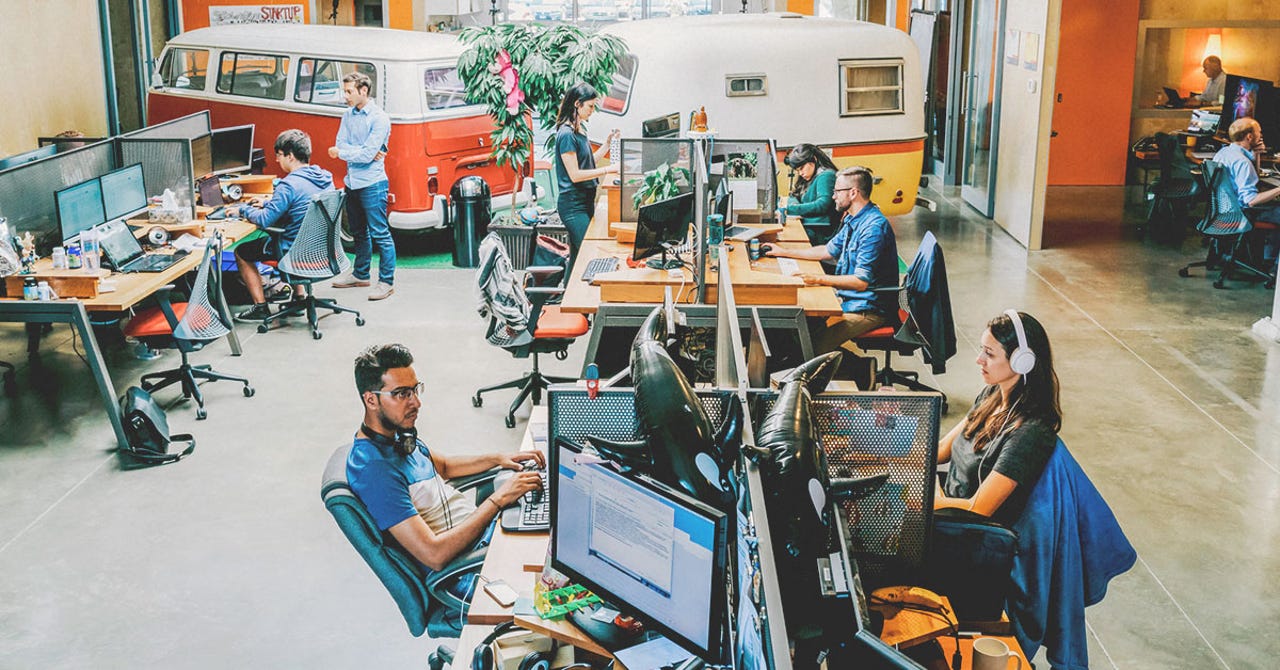Man vs. machine: How a digital job really affects your body and brain


By Matthew Berger
Americans spend about nine and a half hours a day in front of screens, according to the results of Nielsen's 2017 survey of media consumption habits. That's 45 minutes longer than in 2016, and almost two hours longer than 2015.
In short, the time we spend with our eyes glued to screens -- usually seated, and likely not moving -- is increasing at a rapid rate. And most of those hours are spent at work.
As far back as 2003, more than half of Americans were already using a computer at work -- a percentage that has undoubtedly risen since then. And in 2014, 17 million people were employed in the tech industry -- 12 percent of total employment. This is another figure which has likely grown since, and both percentages are sure to continue rising in the future.
Growth in the tech job market, and in the technology that makes our jobs easier, has produced economic growth and efficiencies.
But there may be hidden costs.
Our bodies aren't moving
A 2011 review of research found that just 20 percent of today's jobs require moderate physical activity, down from 50 percent in 1960. That means that the average man today burns 140 fewer calories per day than he did in 1960, and the average woman burns 124 calories fewer per day.
Burning fewer calories means that weight gain is inevitable, unless you restrict your diet. Which we aren't doing: the average person in the United States takes in 23 percent more calories than they did in 1970. As a result of burning fewer calories -- and eating more, the average man now weighs almost 13 more pounds than he did in 1960.
Sedentary kids become sedentary adults
"I've got no reason to think anything's getting better," says the lead author of the 2011 review, Dr. Timothy Church, an exercise researcher at Louisiana State University's Pennington Biomedical Research Center.
In fact, Church thinks it's getting worse, largely because of what's happening before we end up behind the desks. "In the past, it was individuals who used to be really active and thin [who would] hit the working world and become sedentary," he explains. "Now, you have people who are already sedentary entering the workforce."
That's because the 40-year-olds of today are not the 40-year-olds of a couple of decades ago. Video games, tablets, and TV shows have overwhelmingly replaced the common kid activity of the past -- playing outside. That means kids are already primed to get diseases related to a sedentary lifestyle before they even enter the workforce.
So how do these changes in our diets, lifestyles, and work environments translate to our overall health?
A higher risk of obesity means a higher risk of cancer
As sedentary kids enter a workforce filled with sedentary jobs, and as the percentage of those jobs rises, so are obesity rates. Today, one in three U.S. adults are obese, putting them at risk for heart disease, diabetes, cancer, and other health problems.
Indeed, obesity has been tied to an increased risk of at least 13 types of cancer, according to the National Cancer Institute, including:
- breast cancer
- colon cancer
- liver cancer
- prostate cancer
- ovarian cancer
Sitting also ups your risk of diabetes
More sedentary jobs also may mean a higher risk of diabetes. That's because being sedentary, rather than active, slows down your glucose metabolism, making your blood sugar higher. By some estimates, the most inactive people are 112 percent more likely to develop diabetes.
And being a healthy weight doesn't appear to protect you from that risk. Even people at a healthy weight can see their blood sugar levels spike to prediabetes levels if they sit for extended periods, according to one recent study.
Your risk of death is higher, and it doesn't matter if you exercise
Featured
Another study from 2011 found that adults who spent more than four hours in front of the TV or other type of screen were about 125 percent more likely to have a heart attack or similar event, than people who did so for less than two hours a day. They also had a 50 percent higher chance of death.
The kicker? Getting physical activity in addition to the screen time made little difference in the outcomes. A 2009 study by researchers at Pennington Biomedical Research Center made a similar finding. They found there to be a strong "dose-response association" between sitting and dying of heart disease. That means the more time you spend sitting down, the more at-risk you are of dying due to heart disease.
Your mental health is affected, too
Seeing all the studies about how sitting affects our physical health, a team of researchers in Australia were curious about the impacts on our mental health.
They found that men and women who sat at work for more than six hours a day were more likely to experience moderate psychological distress, measured by the K10 scale, than those who sat for less than three hours a day.
Using tech to reverse tech's negative effects
These are all problems that our increased reliance on technology have helped cause. But technology can also help us solve these problems.
Working on a computer typically means more sitting. But guess what? That's not the only way to work. Standing and treadmill desks are gaining popularity, although even Church admits that using such options won't fix the problem all on their own.
Breaking up your sitting patterns throughout the day can help, but Church says what's really needed is more structured exercise, even if it's just a walk. "People just need to go work out. That's [the] cold-hearted reality," he says.
Fortunately, technology has us sorted there. The internet means you don't have to be tethered to a desk to get things done. Smartphones and tablets allow you to head out of the office for an afternoon jog or hike, and still be able to reply to that urgent email you were expecting.
Those devices also come equipped with a range of health trackers, and those offerings are expected to expand in the coming years. Pedometers and diet trackers could give way to diagnostic tools and blood sugar level monitors.
And structured exercise doesn't just mean working out. "I'd like to believe we're going to be more creative about how we get people to be active," says Church, noting that technology can play a role in tricking people into being more active.
"We have to make this stuff fun," he says, citing the Pokémon Go app as a good example of how that has been done effectively. Other fitness games for adults and workforces can also be effective, like those developed by a company he works with, including one where employees are chased by zombies.
We can't escape the prominent and growing role technology plays in our lives, both professionally and personally. Most of us will continue living with our eyes glued to a screen -- because for some of us, it's our job. But it's also possible to use the technology we're so reliant on to combat its negative effects.
Article Resources:
- Trends over 5 decades in U.S. occupation-related physical activity and their associations with obesity
- What's on your table? How America's diet has changed over the decades
- Breaking up prolonged sitting reduces postprandial glucose and insulin responses
- Having desk job 'doubles risk' of heart attack
- Cross-sectional associations between siting at work and psychological distress: Reducing sitting time may benefit mental health
- Physical activity and abnormal blood glucose among healthy weight adults
- Obesity and cancer fact sheet
- Screen-based entertainment time, all-cause mortality, and cardiovascular events: Population-based study with ongoing mortality and hospital events follow-up
- Beyond the numbers: Employment and unemployment